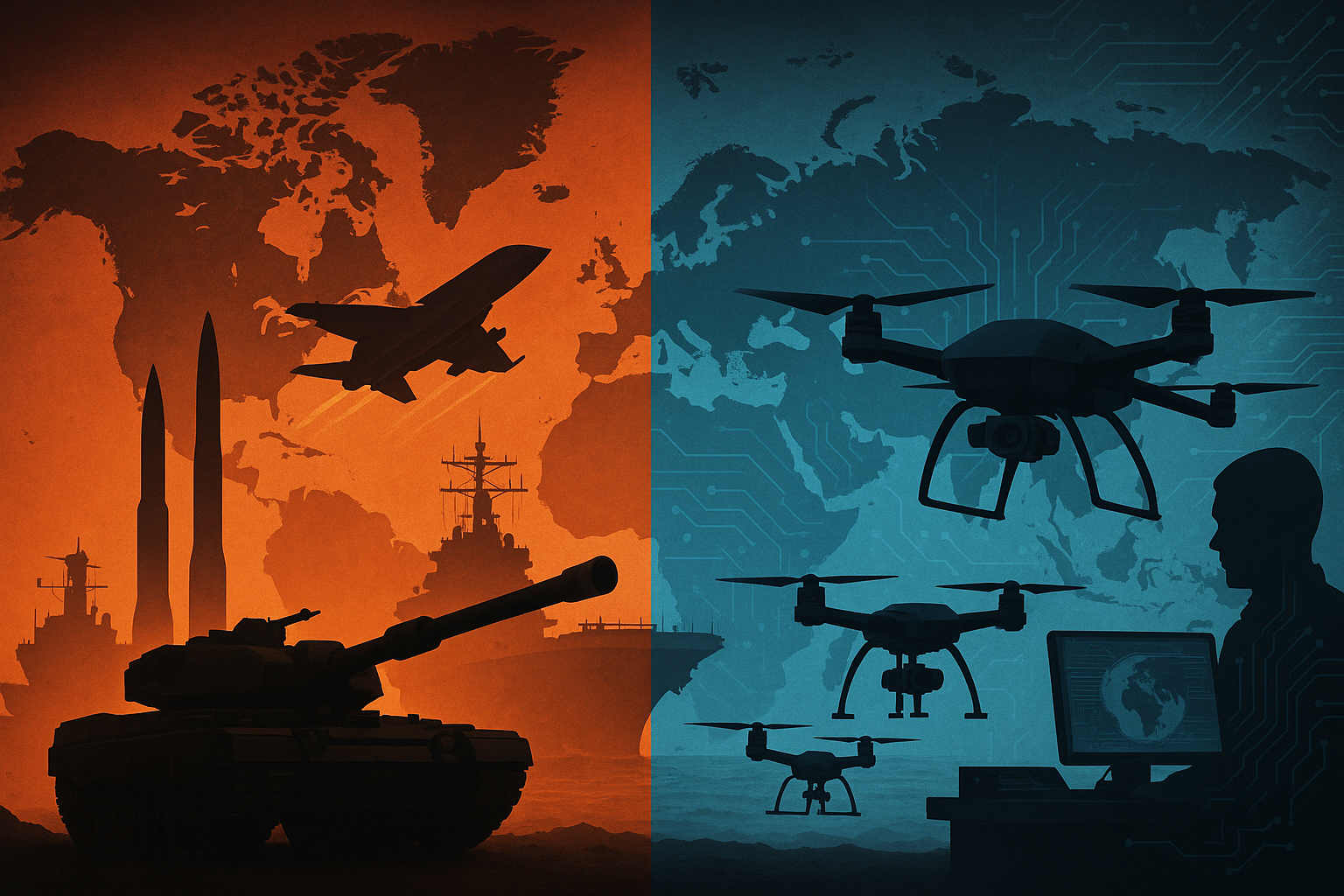A global arms race is accelerating, with nations pouring unprecedented trillions into their defense coffers. Yet, as old paradigms of military might are reasserted with steel and explosive power, a quieter, arguably more profound revolution is underway. Cheap, agile, and intelligent technologies are rewriting the rules of engagement, posing an existential challenge to traditional defense behemoths and potentially redrawing the map of global power. We stand at a fascinating, and frankly unnerving, crossroads where the future of warfare is being forged in a crucible of geopolitical tension and disruptive innovation.
The global cash registers of conflict are ringing at a fever pitch. According to the Stockholm International Peace Research Institute (SIPRI), worldwide military expenditure is projected to hit a staggering $2.718 trillion in 2024. This isn’t just a gentle uptick; it’s a roaring 9.4% surge from 2023, the most dramatic year-on-year escalation since the frosty depths of the Cold War. The United States, long the world’s dominant military spender, is leading the charge, with its Senate Appropriations Committee greenlighting an FY2025 defense budget hovering around $852.2 billion. This vast sum is largely earmarked for shoring up legacy systems – think F-35 fighter jets and sophisticated missile defense networks – a strategy aligning with a renewed focus on great power competition.
Across the Pacific, China, now firmly the world’s second-largest military investor, has allocated a formidable $314 billion for 2024. Its naval expansion, resulting in the largest fleet by sheer number of vessels, signals Beijing’s unambiguous ambition for regional, and increasingly global, influence. Meanwhile, Europe, shaken by the protracted war in Ukraine and wrestling with nagging doubts about the long-term reliability of American security guarantees, is scrambling to rearm. The European Union’s 2025 European Defence Fund has been bolstered to €1.065 billion to spur collaborative research and development. Even post-Brexit Britain is navigating complex diplomatic channels, reportedly negotiating access to the hefty €150 billion Security Action for Europe (SAFE) fund, a clear indicator of the continent-wide urgency to enhance defensive capabilities.
But as these monumental sums are allocated, often towards weapons platforms conceived in a pre-digital age, a seismic shift is occurring on the very nature of the battlefield. The brutal proving grounds of Ukraine have become an unsolicited, real-time laboratory for twenty-first-century warfare. Here, the narrative of overwhelming firepower being the sole determinant of victory is being dramatically, and often tragically, upended.
The New York Times reports a stark reality: drones, many costing between a mere $400 and $1,000, are now implicated in an astonishing 70% of combat deaths and injuries. These nimble, often commercially derived First-Person View (FPV) drones are proving devastatingly effective against multi-million-dollar assets like tanks. Consider the Javelin missile, a sophisticated anti-tank weapon costing approximately $198,000 per unit. Now, its role is increasingly being challenged, if not usurped, by a swarm of far cheaper, adaptable aerial attackers. As The Economist astutely notes, a $400 drone can, in many instances, deliver the destructive impact of a $100,000 GPS-guided artillery shell. This isn’t just incremental improvement; it’s a revolution in cost-benefit calculus.
This technological disruption is largely being driven not by established defense contractors, but by agile private sector innovators. Ukraine’s BRAVE1 initiative, launched in 2023, has become a critical nexus, linking over 750 tech companies directly with military needs. The results are startling: Business Insider highlights the development of 3D-printed explosives costing as little as $3.85 a unit. Swarm drone technology, while not yet fully autonomous on a mass scale, is rapidly evolving, with Ukraine’s Ministry of Strategic Industry actively organizing demonstration tests as recently as October 2024.
This scenario presents what business strategists term the “incumbent’s curse.” Traditional defense giants – the Raytheons and BAE Systems of the world, find themselves in a position uncomfortably reminiscent of Blockbuster Video blindsided by the rise of Netflix. Their often lengthy, bureaucratic, and hugely expensive research and development cycles risk being outpaced by nimble startups and rapid, battlefield-driven innovation. The question looms: can these titans of twentieth-century warfare adapt quickly enough to this new, decentralized, and digitally infused reality?
The implications stretch far beyond the balance sheets of defense corporations; they touch the very foundations of global power dynamics. For decades, American military supremacy has been a cornerstone of its international influence and, as some analysts like Luke Gromen argue, a key underpinning of the US dollar’s status as the world’s reserve currency. Gromen posits that the dollar’s global role is intrinsically linked to America’s capacity to secure vital energy trade routes. Research from Columbia Business School lends weight to this, demonstrating a historical correlation between military strength and financial dominance.
If US military superiority is indeed eroding, and wargames conducted by the RAND Corporation have repeatedly shown US forces struggling in simulated conflicts against peer adversaries like China, as reported in War on the Rocks, the macroeconomic consequences could be profound. A diminished ability to project power could translate into higher borrowing costs for the US and a potential shift in the global financial architecture.
Adding another layer of complexity is what investor Louis Gave has dubbed the “Microsoft-ification of War.” This refers to the democratization of advanced military technologies, empowering non-state actors and smaller nations to challenge superpower advantages at a fraction of the traditional cost. The Houthi rebels’ drone attacks on sophisticated US warships in the Red Sea serve as a potent example. As New Lines Magazine and USNI Proceedings have detailed, these relatively inexpensive drone assaults have forced the Pentagon to expend hundreds of millions of dollars in defensive countermeasures, highlighting a stark asymmetry that favors the disruptor.
The market outlook for the defense sector is thus a tale of two cities. There’s a clear bull case for traditional defense contractors, buoyed by record government budgets that will sustain demand for their existing platforms for some time. Defense stocks have rallied on the back of these massive contracts. However, a compelling bear case suggests that these legacy systems face a growing risk of obsolescence as disruptive technologies mature. Astute investors are already shifting their gaze, and capital, towards AI, drone technology, and cybersecurity firms, the potential frontrunners in this new era.
For policymakers, the challenge is acute. A critical rebalancing of budgets is needed, shifting emphasis from purely legacy systems towards AI, electronic warfare, and drone swarm capabilities. Strengthening public-private R&D partnerships is paramount to avoid the national security equivalent of the “Blockbuster syndrome,” ensuring that state-of-the-art innovation translates rapidly into deployable capabilities.
And for the defense corporations themselves, the message is stark: adapt or risk obsolescence. This means accelerating the development of modular, software-upgradable systems that can evolve at the pace of technological change, not at the pace of traditional procurement cycles.
The global defense industry is caught in a fascinating, high-stakes clash between the inertia of record spending on established paradigms and the relentless, disruptive force of technological innovation. While traditional contractors may reap short-term benefits from the current surge in expenditure, their long-term survival and relevance hinge on their ability to embrace and integrate the decentralized, agile, and tech-driven nature of future conflict. Failure to do so won’t just impact bottom lines; it could significantly alter the global balance of power. As one observer starkly put it, “The next Pearl Harbor won’t be a carrier strike, it’ll be a 500$ drone disabling a $13bn warship.” In this rapidly evolving landscape, foresight, agility, and a willingness to challenge sacred cows are no longer just strategic advantages; they are prerequisites for survival.
Disclaimer: Important Legal and Regulatory Information
This report is for informational purposes only and should not be construed as financial, investment, legal, tax, or professional advice. The views expressed are purely analytical in nature and do not constitute financial guidance, investment recommendations, or a solicitation to buy, sell, or hold any financial instrument, including but not limited to commodities, securities, derivatives, or cryptocurrencies. No part of this publication should be relied upon for financial or investment decisions, and readers should consult a qualified financial advisor or regulated professional before making any decisions. Bretalon LTD is not authorized or regulated by the UK Financial Conduct Authority (FCA) or any other regulatory body and does not conduct activities requiring authorization under the Financial Services and Markets Act 2000 (FSMA), the FCA Handbook, or any equivalent legislation. We do not provide financial intermediation, investment services or portfolio management services. Any references to market conditions, asset performance, or financial trends are purely informational and nothing in this report should be interpreted as an offer, inducement, invitation, or recommendation to engage in any investment activity or transaction. Bretalon LTD and its affiliates accept no liability for any direct, indirect, incidental, consequential, or punitive damages arising from the use of, reliance on, or inability to use this report. No fiduciary duty, client-advisor relationship, or obligation is formed by accessing this publication, and the information herein is subject to change at any time without notice. External links and references included are for informational purposes only, and Bretalon LTD is not responsible for the content, accuracy, or availability of third-party sources. This report is the intellectual property of Bretalon LTD, and unauthorized reproduction, distribution, modification, resale, or commercial use is strictly prohibited. Limited personal, non-commercial use is permitted, but any unauthorized modifications or attributions are expressly forbidden. By accessing this report, you acknowledge and agree to these terms-if you do not accept them, you should disregard this publication in its entirety.



